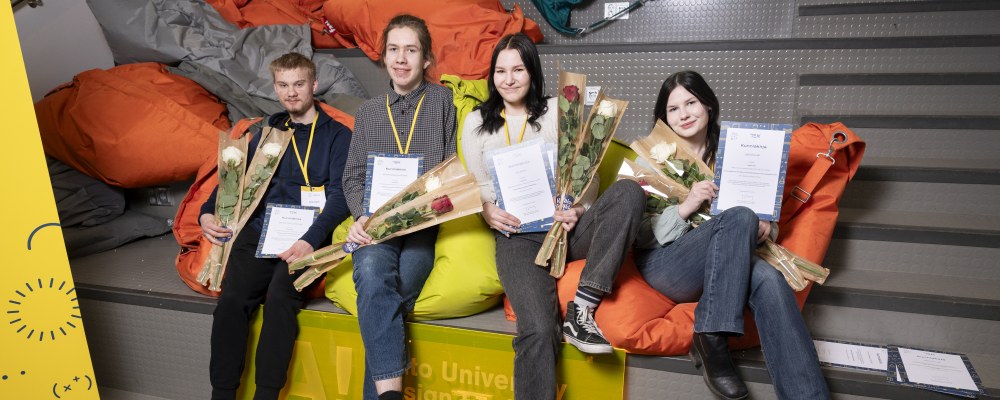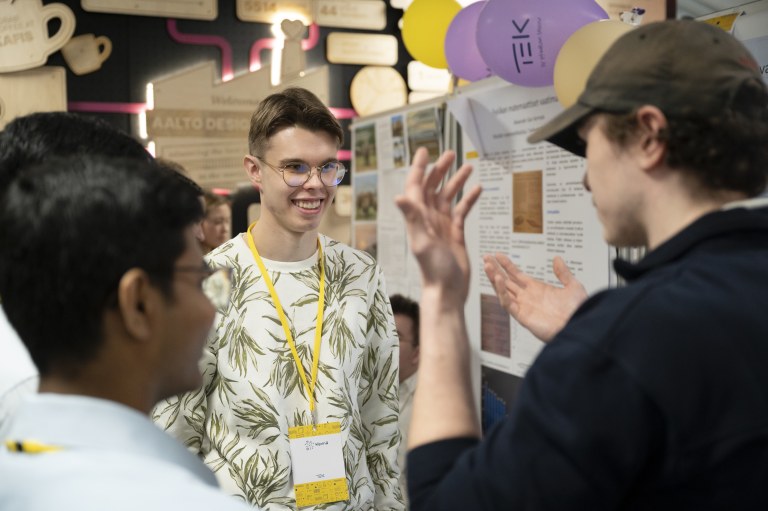
The Kipinä science competition for young people was organised for the first time this spring. The final event was held at Aalto Design Factory in Espoo on 16 April 2025. Organised by TEK, the competition was won by three projects:
- Sofia Koivumäki, 19, studied the effect of hormone pollution on plants. Koivumäki is studying in the IB programme at Tampereen lyseon lukio high school.
- Zofia Järvinen, 18, studied ways to determine the stage of the life cycle of stars. Järvinen is studying in the natural sciences programme at Tampere Classical Upper Secondary School.
- Hermanni Sallinen, 17, and Niilo Sipilä, 17, studied killing bacteria with an electric fly swatter. They study at Valkeakoski Tietotie Upper Secondary School in the Päivölä School of Mathematics.
The first prizes are worth €1,000. The four winners of the Kipinä competition will travel to Latvia in September to represent Finland at the EU Contest for Young Scientists (EUCYS).
Read more about the winning projects below.
More knowledge on the effect of hormones
Sofia Koivumäki’s project is titled An Investigation on the Effect of Hormone Pollution on Surrounding Plant Life. The project was supervised by Anna-Maaria D’Incau.
In this project, Koivumäki studied two types of pills. One is a pill that balances hormone levels, for example after pregnancy. The other is a combination birth control pill. Koivumäki studied how different amounts of hormones in water affect the growth of bean plants.
Koivumäki found that small amounts of hormones had little effect on plant growth, but plants exposed to higher hormone levels (50–100 mg) did not grow leaves.
“I don’t think people talk about this topic very much, and there isn’t enough knowledge about it. I wanted to draw attention to this issue. I also wanted to choose an ecological topic, because the environment and nature are important to me. I studied hormones because I want to go to medical school,” Koivumäki explains.
The study was an Extended Essay for the IB programme at Tampereen lyseon lukio high school. Koivumäki is pleased to have been able to complete the entire project independently.
Support from Ursa Tampere for studying stars
The title of Zofia Järvinen’s project is Tähtien elinkaaren vaiheen määrittäminen (Determining the Stage of the Life Cycle of Stars). The project was supervised by Pasi Ahtola.
Järvinen studied the life cycle of stars as well as their properties, brightness and temperature. The project was done in collaboration with Astronomical Club Tampereen Ursa. Järvinen is the vice chair of this astronomical association. Thanks to the collaboration, Järvinen had access to the observatory in Kauppi and was able to use existing research equipment.
“I’ve been an amateur astronomer for a long time. It was fascinating to study something as ordinary as the starry sky,” says Järvinen.
Järvinen is a theoretical person. Järvinen was interested in learning how stars work and what happens in their core. The scale of the universe seemed fascinating.
The project was a research project for the natural sciences programme at Tampere Classical Upper Secondary School.
Fighting bacteria with a fly swatter
Hermanni Sallinen and Niilo Sipilä's project is titled Bakteerien tappaminen sähkökärpäslätkällä (Killing bacteria with an electric fly swatter). The project was supervised by Esa Lappi and Merikki Lappi.
Sallinen and Sipilä studied the use of a pulsed electric field for water sterilization. Their research showed that creating an electric field around a liquid has a statistically significant decreasing effect on the bacterial count of the liquid.
“We built a prototype using an everyday tool, an electric fly swatter. We tested its effectiveness on bacterial cultures,” says Sallinen.
The project was part of Sallinen and Sipilä’s studies. They explain that every second-year student at the Päivölä School of Mathematics carries out a research project. They chose this topic, because Sipilä was interested in high voltage and its applications.
For Sallinen, the best part of the project was designing the portable prototype device and presenting the work in the final event of the Kipinä competition. Sipilä enjoyed conducting the actual experiments.
“Despite being repetitive, they were interesting,” Sipilä says.
(This article continues after the photo.)

Kipinä 2025
Organised by the Academic Engineers and Architects in Finland (TEK), Kipinä is a science competition for young people aged 13–19 throughout Finland. The aim is to select Finland’s representatives for the EU Contest for Young Scientists (EUCYS). Kipinä was organised for the first time this year.
Kipinä received 93 projects by the deadline on 1 February 2025, of which the panel of judges selected 19 finalists. A total of 135 young people entered the competition, with 25 advancing to the finals.
In addition to a panel of judges, experts in the research topics covered and a jury participated in evaluating the projects. A total of 60 people took part in the evaluation of the young people’s entries.
All finalists received at least a recognition award as a result of the thorough evaluation process.